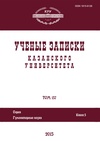Представление глаголов физиологического действия и состояния в лексикографической базе данных татарских глаголов
Representing Tatar Verbs Denoting Physiological Actions and States in the Lexicographic Database
Author(s): Alfia Makarimovna GalievaSubject(s): Language studies, Morphology, Syntax, Lexis, Semantics
Published by: Казанский (Приволжский) федеральный университет
Keywords: Tatar language; verb of physiological state; verb of physiological action; semantics; lexicographic database; semantic classes of vocabulary;
Summary/Abstract: This paper describes how Tatar verbs denoting physiological actions and states are represented in lexicographic databases. The general principles of representing verbs in the database and the basic classification parameters have been given. The thematic (ontological) classes of verbs essentially are heterogeneous aggregations of lexemes of various semantic, structural, and syntactic features. We suggest the way to distinguish more particular and homogeneous semantic ensembles within large thematic classes. Our classification of Tatar verbs is based on the following parameters of verbs: thematic features linked with the verb’s thematic class; derivational features related to the verb’s derivation pattern; grammatical features associated with the valency changing operations of voice affixes (possibility of producing grammatical voice derivatives and particular meanings of voice forms); syntactic features related to the allowable predicate-argument structure and thematic roles of arguments. A number of examples demonstrating that Tatar verbs denoting physiological actions and states form a broad thematic class of items with different semantic, derivational, syntactic characteristics have been provided; within this class we select 28 subclasses, a detailed description of the lexical content of four such subclasses has been performed. Many of the analyzed lexemes lack direct equivalents in the Russian language. Linguistic information represented in the database has both applied and theoretical dimensions. So, it can be used to develop computer applications and as an empirical basis for explicating the morphosyntactic behavior of words and for carrying out a consistent compositional analysis of verbal predicates.
Journal: Ученые записки Казанского университета. Серия Гуманитарные науки
- Issue Year: 160/2018
- Issue No: 5
- Page Range: 1219-1234
- Page Count: 16
- Language: Russian

